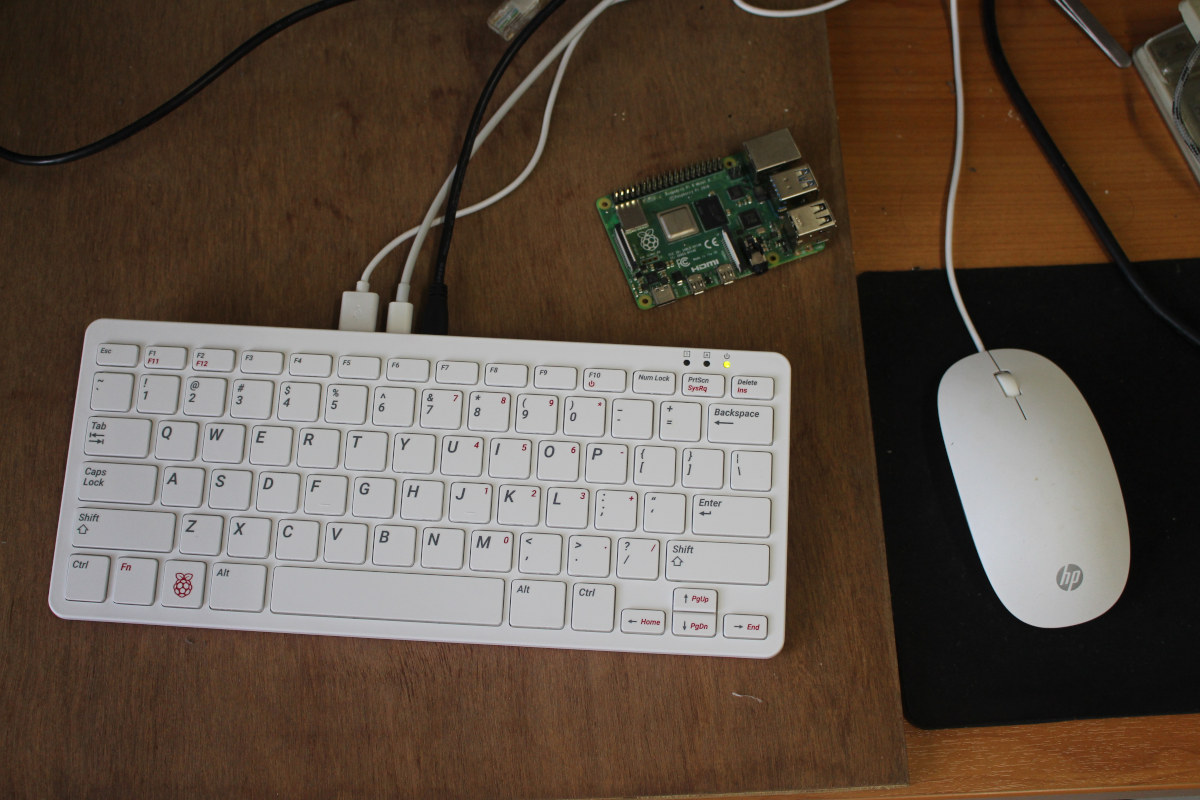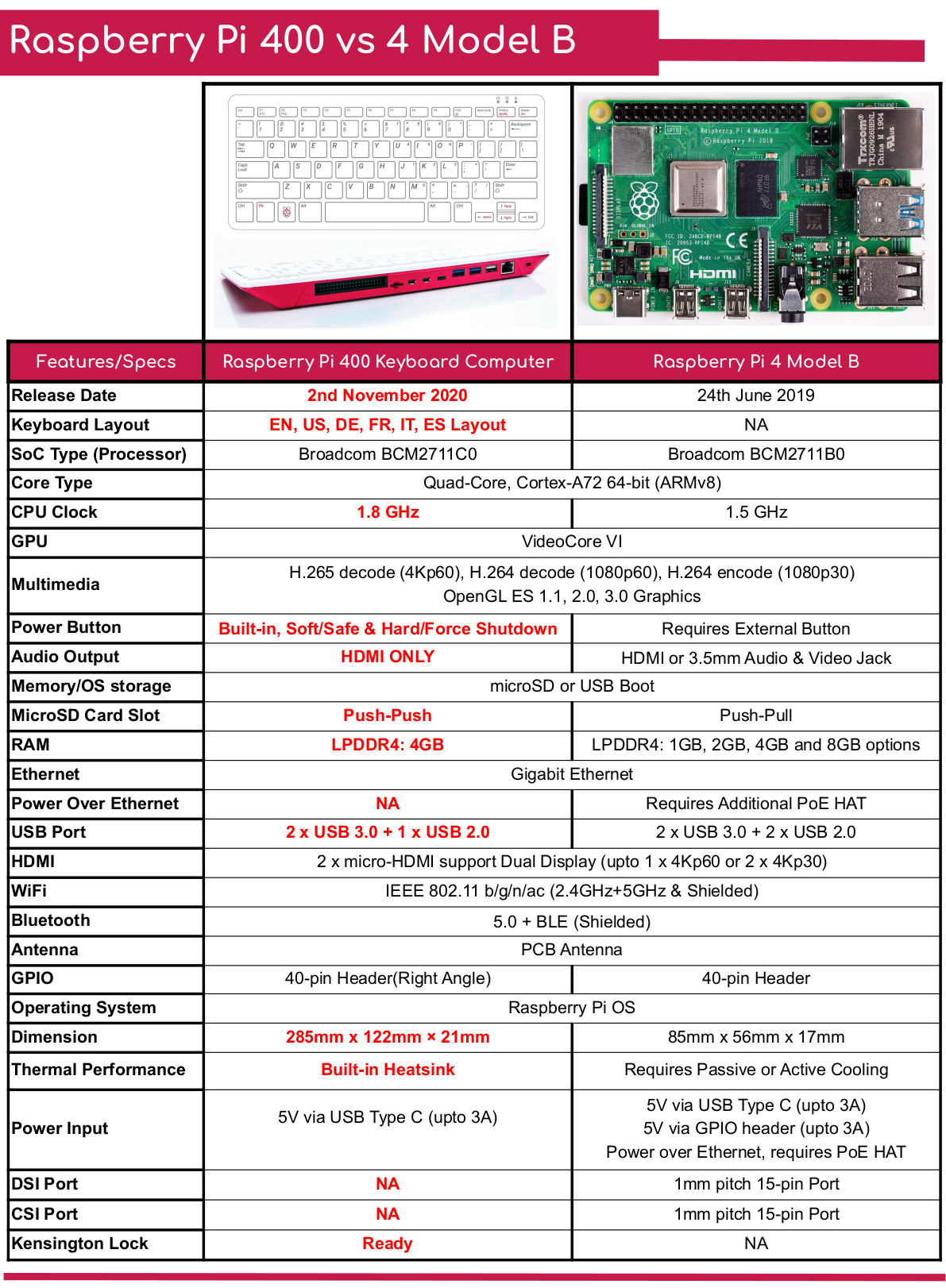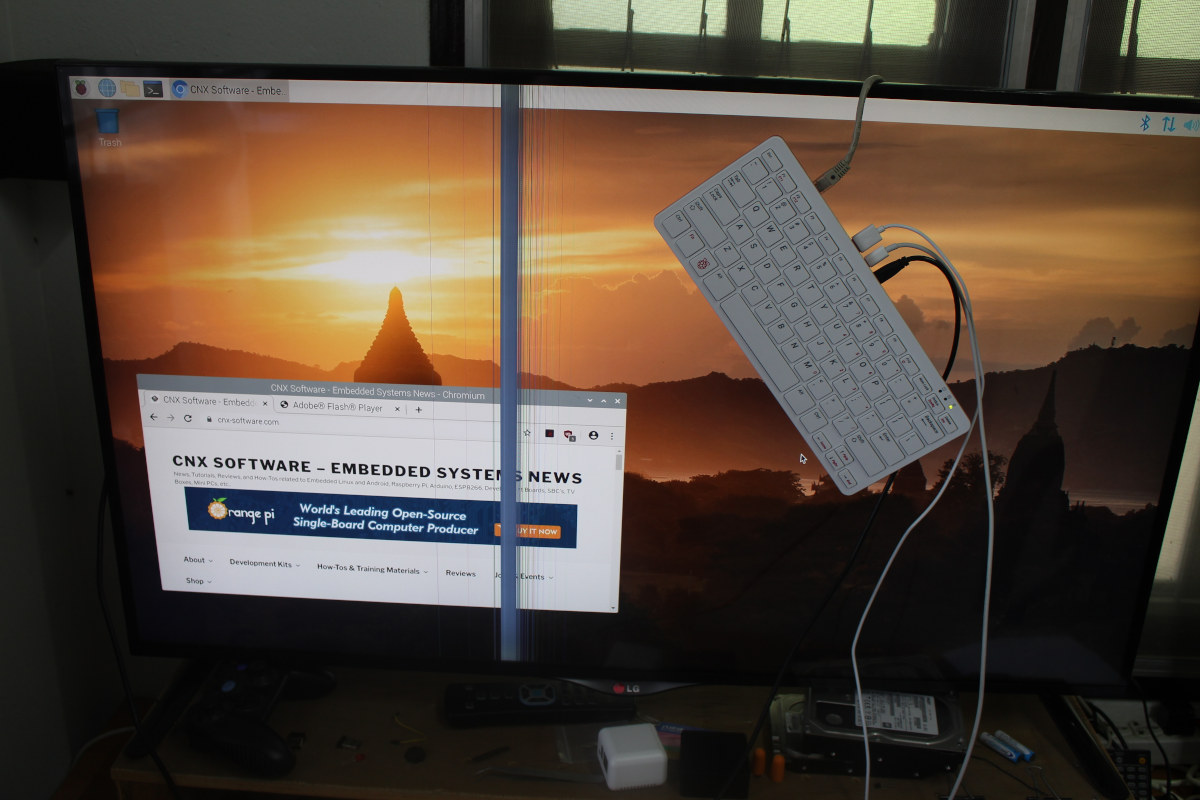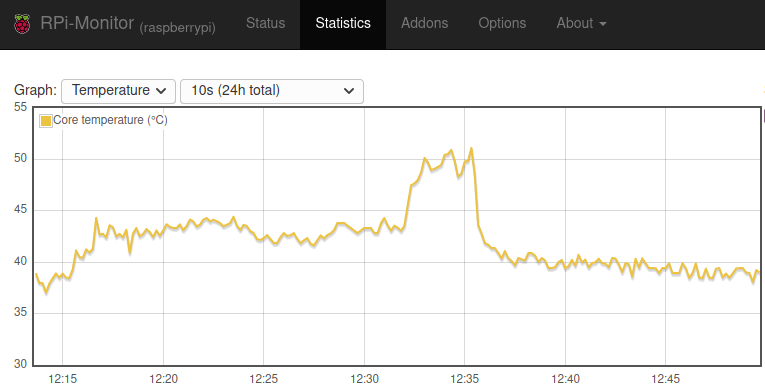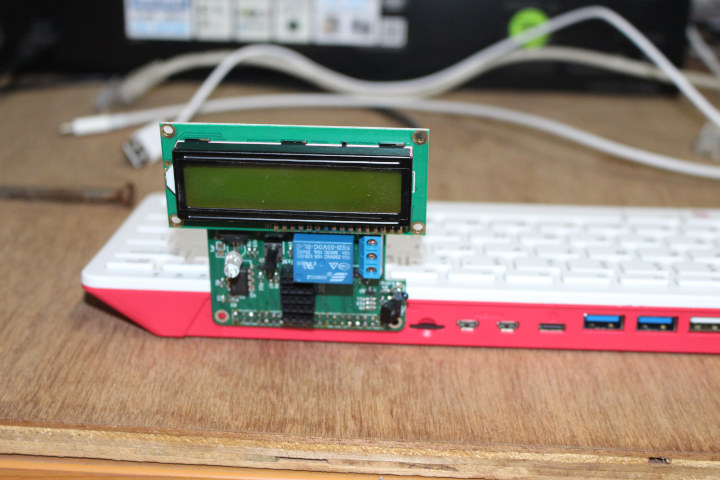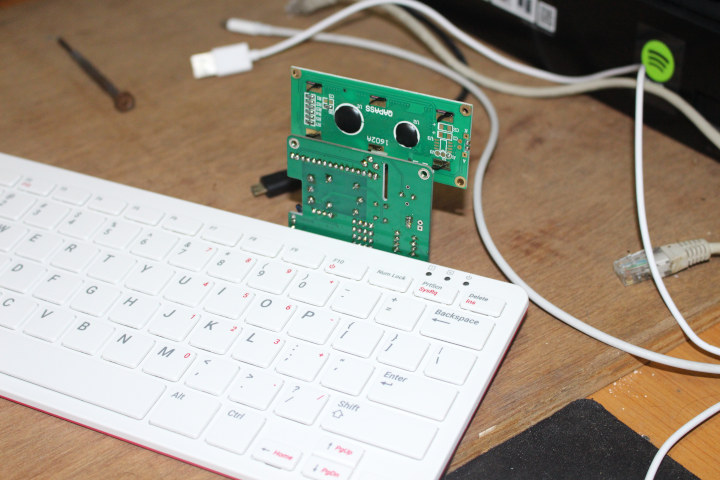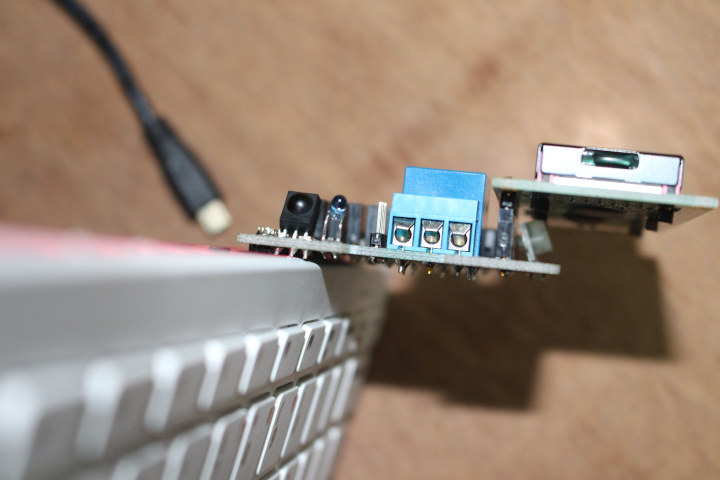Raspberry Pi 400 keyboard computer with Broadcom BCM2711C0 1.8 GHz processor has just launched, and we already published a teardown of the Raspberry Pi 400 hardware to check out the cooling solution and overall hardware design.
In this review, we’ll mostly focus on Raspberry Pi 400 and Raspberry Pi 4 differences, since both devices mostly rely on the same chips. After checking the different features, we’ll run Thomas Kaiser’s “SBC Bench” script to test thermal cooling and benchmark both RPi hardware platforms.
Raspberry Pi 400 vs Raspberry Pi 4 Model B Features
Since under the hood, the two platforms are very similar, we’ll highlight the difference as shown in the table below courtesy of Cytron.
Price is not shown in the table above, but Raspberry Pi 400 costs $70, while Raspberry Pi 4 with 4GB goes for $55. That’s $15 extra for a keyboard, case, and cooling solution, so the price is very attractive.
Stock performance is a little higher thanks to a 1.8 GHz processor, but as we’ve seen in the past it’s always possible to overclock Raspberry Pi 4 to 2.0+ GHz provided you’ve got a proper cooling solution.
The keyboard PC adds a… keyboard as one should expect, with US, UK, DE, FR, IT, or ES layout, a power button that enables soft power on/off and may help to prevent file system corruption, as well as a Kensington Lock hole to protect again theft, for example at school. IMHO, it’s a more portable solution, than having a keyboard and Raspberry Pi 4 + heatsink or fanless case.
Having said that, you’ll lose some features including the CSI camera and DSI display connectors, PoE, the 3.5mm audio jack, and one USB 2.0 port. The latter is not really a problem, as in many cases, it would be used by an external USB keyboard.
Raspberry Pi OS System Info
The keyboard computer is software-compatible with Raspberry Pi 4, so I could just install Raspberry Pi OS 32-bit released last August for the review.
The user experience is exactly the same as in Raspberry Pi 4, so let’s check out some of the system information:
|
1 2 3 4 5 6 7 8 9 10 11 12 13 14 15 16 17 18 19 20 21 22 23 24 25 26 27 28 29 30 31 32 33 |
pi@raspberrypi:~ $ cat /etc/issue Raspbian GNU/Linux 10 \n \l pi@raspberrypi:~ $ uname -a Linux raspberrypi 5.4.72-v7l+ #1356 SMP Thu Oct 22 13:57:51 BST 2020 armv7l GNU/Linux pi@raspberrypi:~ $ df -h Filesystem Size Used Avail Use% Mounted on /dev/root 15G 7.8G 6.0G 57% / devtmpfs 1.8G 0 1.8G 0% /dev tmpfs 1.9G 0 1.9G 0% /dev/shm tmpfs 1.9G 8.6M 1.9G 1% /run tmpfs 5.0M 4.0K 5.0M 1% /run/lock tmpfs 1.9G 0 1.9G 0% /sys/fs/cgroup /dev/mmcblk0p1 253M 54M 199M 22% /boot tmpfs 383M 0 383M 0% /run/user/1000 pi@raspberrypi:~ $ cat /proc/cpu cpu/ cpuinfo pi@raspberrypi:~ $ cat /proc/cpuinfo processor : 0 model name : ARMv7 Processor rev 3 (v7l) BogoMIPS : 108.00 Features : half thumb fastmult vfp edsp neon vfpv3 tls vfpv4 idiva idivt vfpd32 lpae evtstrm crc32 CPU implementer : 0x41 CPU architecture: 7 CPU variant : 0x0 CPU part : 0xd08 CPU revision : 3 ... Hardware : BCM2711 Revision : c03130 Serial : 10000000c311ea9d Model : Raspberry Pi 400 Rev 1.0 |
No differences here, except or the revision code – c03130 – with “13” being the code for Raspberry Pi 400 and the first “0” meaning it’s manufactured by Sony UK.
|
1 2 3 4 5 6 7 8 9 10 11 12 13 14 15 16 17 18 19 20 21 22 23 24 25 26 27 28 29 30 31 32 33 34 35 36 37 38 39 40 41 42 43 44 |
pi@raspberrypi:~ $ sudo inxi -Fc0 System: Host: raspberrypi Kernel: 5.4.72-v7l+ armv7l bits: 32 Console: tty 1 Distro: Raspbian GNU/Linux 10 (buster) Machine: Type: ARM Device System: Raspberry Pi 400 Rev 1.0 details: BCM2711 rev: c03130 serial: 10000000c311ea9d Argument "Raspberry Pi 400 Rev 1.0" isn't numeric in sprintf at /usr/bin/inxi line 6969. CPU: Topology: Quad Core model: ARMv7 v7l variant: cortex-a72 bits: 32 type: MCP Speed: 1800 MHz min/max: 600/1800 MHz Core speeds (MHz): 1: 1100 2: 1100 3: 1100 4: 1100 Graphics: Device-1: bcm2711-vc5 driver: vc4_drm v: N/A Device-2: bcm2711-hdmi0 driver: N/A Device-3: bcm2711-hdmi1 driver: N/A Display: server: X.org 1.20.4 driver: modesetting unloaded: fbdev tty: 80x24 Message: Advanced graphics data unavailable in console for root. Audio: Device-1: bcm2835-audio driver: bcm2835_audio Device-2: bcm2711-hdmi0 driver: N/A Device-3: bcm2711-hdmi1 driver: N/A Sound Server: ALSA v: k5.4.72-v7l+ Network: Message: No ARM data found for this feature. IF-ID-1: eth0 state: up speed: 1000 Mbps duplex: full mac: dc:a6:32:d7:ed:db IF-ID-2: wlan0 state: down mac: dc:a6:32:d7:ed:dd Drives: Local Storage: total: 14.84 GiB used: 7.80 GiB (52.6%) ID-1: /dev/mmcblk0 vendor: SanDisk model: SL16G size: 14.84 GiB Partition: ID-1: / size: 14.29 GiB used: 7.75 GiB (54.2%) fs: ext4 dev: /dev/mmcblk0p2 ID-2: /boot size: 252.0 MiB used: 53.9 MiB (21.4%) fs: vfat dev: /dev/mmcblk0p1 Sensors: System Temperatures: cpu: 39.4 C mobo: N/A Fan Speeds (RPM): N/A Info: Processes: 165 Uptime: 5m Memory: 3.81 GiB used: 251.5 MiB (6.4%) gpu: 76.0 MiB Init: systemd runlevel: 5 Shell: bash inxi: 3.0.32 |
Mostly the same as Raspberry Pi 4, except for the 1.8 GHz frequency, and the cool 39.4°C system temperature in a room at 28°C. That also means it’s a candidate for overclocking, but I have not tried it in this review
Raspberry Pi 400 Benchmarks and Thermal Testing
I’ve installed both rpimonitor and SBC Bench for this section. Here are the results:
|
1 2 3 4 5 6 7 8 9 10 11 12 13 14 15 16 17 18 19 20 21 22 23 24 25 26 27 28 29 30 |
sudo ./sbc-bench.sh -c sbc-bench v0.7.4 Installing needed tools. This may take some time... Done. Checking cpufreq OPP... Done. Executing tinymembench. This will take a long time... Done. Executing OpenSSL benchmark. This will take 3 minutes... Done. Executing 7-zip benchmark. This will take a long time... Done. Checking cpufreq OPP... Done. It seems neither throttling nor frequency capping has occured. Memory performance: memcpy: 2675.4 MB/s memset: 3107.4 MB/s (0.9%) 7-zip total scores (3 consecutive runs): 6581,6535,6533 OpenSSL results: type 16 bytes 64 bytes 256 bytes 1024 bytes 8192 bytes 16384 bytes aes-128-cbc 74936.49k 91939.58k 99726.17k 101606.74k 102298.97k 102263.47k aes-128-cbc 75166.77k 92169.83k 99692.63k 101724.50k 102206.12k 102285.31k aes-192-cbc 67517.95k 80832.83k 86475.95k 87858.52k 88342.53k 88457.22k aes-192-cbc 67460.47k 80889.83k 86204.16k 87939.75k 88473.60k 88397.14k aes-256-cbc 61194.19k 72072.73k 76320.00k 77589.85k 77914.11k 77949.61k aes-256-cbc 61098.42k 72037.61k 76419.50k 77493.59k 77933.23k 77824.00k Full results uploaded to http://ix.io/2Cyi. Please check the log for anomalies (e.g. swapping or throttling happenend) and otherwise share this URL. |
No throttling as been detected, and the temperature chart shows why:
It started around 37°C at idle and peaked a little over 50°C during 7-zip multi-threaded benchmarks.
I won’t compare it to bare a Raspberry Pi 4 since we know how it goes, but instead to a Raspberry Pi 4 with KKSB fanless metal case @ 1.5 and 2.0 GHz.
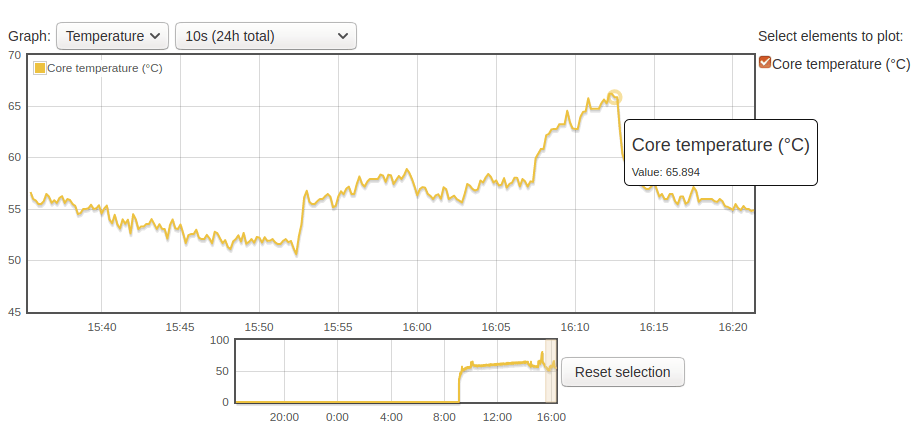
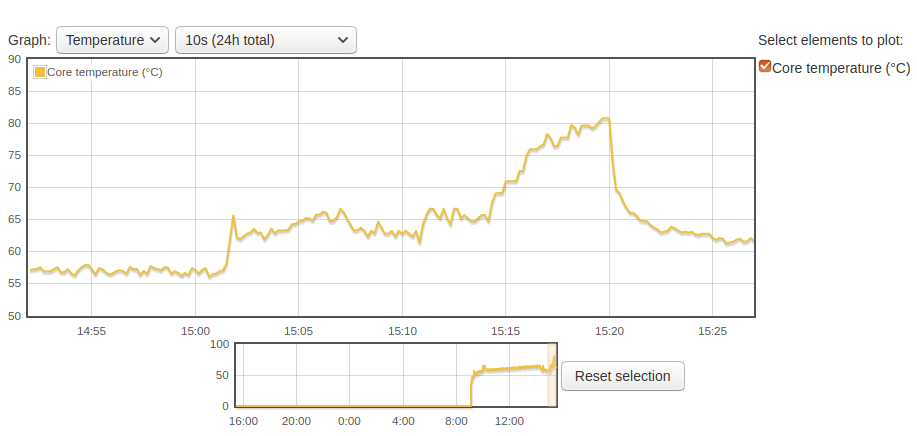
Note the charts above were produced in February 2020 with the latest firmware that included all recent optimizations for cooling and lower power consumption. Needless to say, the results are impressive as Raspberry Pi 400 is equipped with an adequate cooling solution.
Now let’s compare the benchmarks results (higher is better) and max temperatures (lower is better):
| Raspberry Pi 400 @ 1.8 GHz | Raspberry Pi 4 @ 1.5 GHz | Raspberry Pi @ 2.0 GHz | |
|---|---|---|---|
| memset (MB/s) | 2675.4 | 2662.5 | 2749.1 |
| memcpy (MB/s) | 3107.4 | 3436.9 | 3849.9 |
| 7-zip | 6549.66 | 5454 | 6807 |
| OpenSSL (hash/s) AES-256-CBC - 16KB | 77824.00k | 64951.64k | 86567.59k |
| Max temperature (°C) | 51.6 | 65.2 | 80.3 |
7-zip and OpenSSL mostly follow the CPU frequency, but somehow memset and memcpy show lower memory bandwidth in Raspberry Pi 400. The keyboard PC is better at cooling thanks to the large heat spreader that almost matches the results with active cooling.
Raspberry Pi 400 and HAT expansion boards
Raspberry Pi 400 comes with the traditional 40-pin header which can easily be used with jumper cables, or a 40-pin ribbon cable to HAT expansion boards. But I don’t own the latter, so I wonder if I could somehow plug a HAT directly into the keyboard. I dusted off RabbitMax Flex Pi HAT to give it a try.
Pin 1 and Pin 40 are clearly marked on the keyboard, so it’s easy to plug it correctly, but depending on the model it may not fit perfectly, as some pins from the add-on board may prevent full insertion.
If your HAT board does not have pins on the bottom side around one centimeter above the 40-pin header it should be OK. Nevertheless, it’s probably a better idea to get a ribbon cable.
Final words
I have to say I’m impressed, the Raspberry Pi Foundation has done a great job here. Raspberry Pi 400 keyboard PC comes with most goodies from Raspberry Pi 4, but you don’t have to mess with cases or heatsinks for cooling, it just works great out of the box, and I’m sure it will be popular especially in education settings. It’s also priced aggressively at just over $15 an equivalent Raspberry Pi 4 SBC with 4GB RAM, or about the price – or even lower in some cases – of a fanless Raspberry Pi metal case.
It’s not for everyone though. First, it’s not practical/suitable for embedded projects where the single board computer form factor remains ideal. Educators must keep in mind that any projects relying on the Raspberry Pi camera and/or display will not be possible, nor any project with PoE, although I’d kind of like the concept of a PoE powered keyboard PC…
I’d like to thank Cytron for sending a review sample. They sell Raspberry Pi 400 keyboard computer and ship it worldwide for $70 plus taxes and shipping.

Jean-Luc started CNX Software in 2010 as a part-time endeavor, before quitting his job as a software engineering manager, and starting to write daily news, and reviews full time later in 2011.
Support CNX Software! Donate via cryptocurrencies, become a Patron on Patreon, or purchase goods on Amazon or Aliexpress


